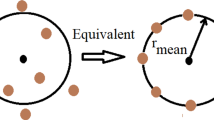Abstract
Crack propagation in brittle rock was simulated under different conditions to describe fracturing behavior of rocks due to the applied stress e.g., water pressure. It is assumed that pre-existing cracks initiate and propagate from the edges of the borehole. The two-dimensional finite element fracture code Franc2D with the non-cohesive method was used for computing the stress intensity factor (SIF), energy-release rates (G), and crack propagation and fracturing time. Static tensile and normal-distributed stresses were used within Franc2D to describe the fracture creation and propagation. Therefore, the pressure inside the bore hole was distributed as a tensile load along with the crack faces. Different scenarios were simulated by changing the boundary conditions, crack initiation, and propagation paths. The SIF determines the amount of tensile failure that is required to create a fracture. Then, the injection rate and pressure can be determined. The direction of fracturing is perpendicular to the maximum applied stresses. The crack propagation direction was compared with experimental observations taken from the literature. The predefined SIF solutions were modified according to the Franc2D solutions. Hence, the ability to use Franc2D for fracture simulation in brittle rock was demonstrated.

















Similar content being viewed by others
References
A.P. Bunger, J. Mclennan, R. Jeffrey, in Effective And Sustainable Hydraulic Fracturing, Brisbane, vol. 9, pp. 9–10
J.-Q. Xiao, D.-X. Ding, F.-L. Jiang, G. Xu, Fatigue damage variable and evolution of rock subjected to cyclic loading. Int. J. Rock Mech. Min. Sci. 47(3), 461–468 (2010)
B. Singhal, R. Gupta, Applied Hydrogeology of Fractured Rocks (Springer, New York, 1999)
J. Adachi, E. Siebrits, A. Peirce, J. Desroches, Computer simulation of hydraulic fractures. Int. J. Rock Mech. Min. Sci. 44(5), 739–757 (2007)
Q. Rao, Z. Sun, O. Stephansson, C. Li, B. Stillborg, Shear fracture (Mode II) of brittle rock. Int. J. Rock Mech. Min. Sci. 40(3), 355–375 (2003)
L.H.S.W. Cui, A.D. Cheng, D.H.S.W. Leshchinsky, Y.H.S.W. Abousleiman, J.C. Roegiers, Stability analysis of an inclined borehole in an isotropic poroelastic medium, in 35th US Symp. Rock Mech. (1995).
Cornell Fracture Group, FRANC2D Version 3.2 (2010). [Online]. Available: http://www.cfg.cornell.edu/software/franc2d_casca.htm. Accessed 07 Jul 2013
A.M. Al-Mukhtar, H. Biermann, P. Hübner, S. Henkel, Determination of some parameters for fatigue life in welded joints using fracture mechanics method. J. Mater. Eng. Perform. 19(9), 1225–1234 (2010)
S.C. Hee, A.D. Jefferson, Two Dimensional Analysis of a Gravity Dam Using The Program (Cardiff University, Cardiff, 2003)
A.M. Al-Mukhtar, The Safety analysis concept of welded components under cyclic loads using components under cyclic loads using (Technische Universität Bergakademie Freiberg, 2010).
F. Erdogan, G.C. Sih, On the crack extension in plates under plane loading and transverse shear. J. Fluids Eng. 85(4), 519–525 (1963)
B.K. Atkinson, H.B. Jovanovich, Fracture Mechanics (Academic Press, New York, 1987)
J.L. Miskimins, S. Green, Hydraulic Fracturing Laboratory Test on a Rock with Artificial Discontinuities (2006)
L. Casas, J. Miskimins, A. Black, S. Green, Laboratory hydraulic fracturing test on a rock with artificial discontinuities. Proc. SPE Annu. Tech. Conf. Exhib. (2006)
P. Wawrzynek, A. Ingraffea, FRANC2D-A Two Dimensional Crack Propagation Simulator, Version 2.7: User’s Guide, 1993
L. Murdoch, J. Richardson, Forms and sand transport in shallow hydraulic fractures in residual soil. Can. Geotech. J. 1073, 1061–1073 (2006)
H. Chen, H. Tang. Method to calculate fatigue fracture life of control fissure in perilous rock. Appl. Math. Mech. 28, 643–649 (2007)
B.J. Carter, A.R. Ingraffea, T. Engelder, Modeling Ithaca’ s Natural Hydraulic Fractures (A.A. Balkema, Rotterdam, 2000)
C. Zhao, H. Matsuda, C. Morita, M.R. Shen, Study on failure characteristic of rock-like materials with an open-hole under uniaxial compression. Strain 47(5), 405–413 (2011)
Acknowledgments
This work is a part of the Post doctorate research project ‘Hot Dry Rock’. Support from the Institute of Geology, TU Bergakademie Freiberg, Germany and from the Institute of International Education (IIE), USA is gratefully appreciated.
Author information
Authors and Affiliations
Corresponding author
Rights and permissions
About this article
Cite this article
Al-Mukhtar, A.M., Merkel, B. Simulation of the Crack Propagation in Rocks Using Fracture Mechanics Approach. J Fail. Anal. and Preven. 15, 90–100 (2015). https://doi.org/10.1007/s11668-014-9907-2
Received:
Published:
Issue Date:
DOI: https://doi.org/10.1007/s11668-014-9907-2




